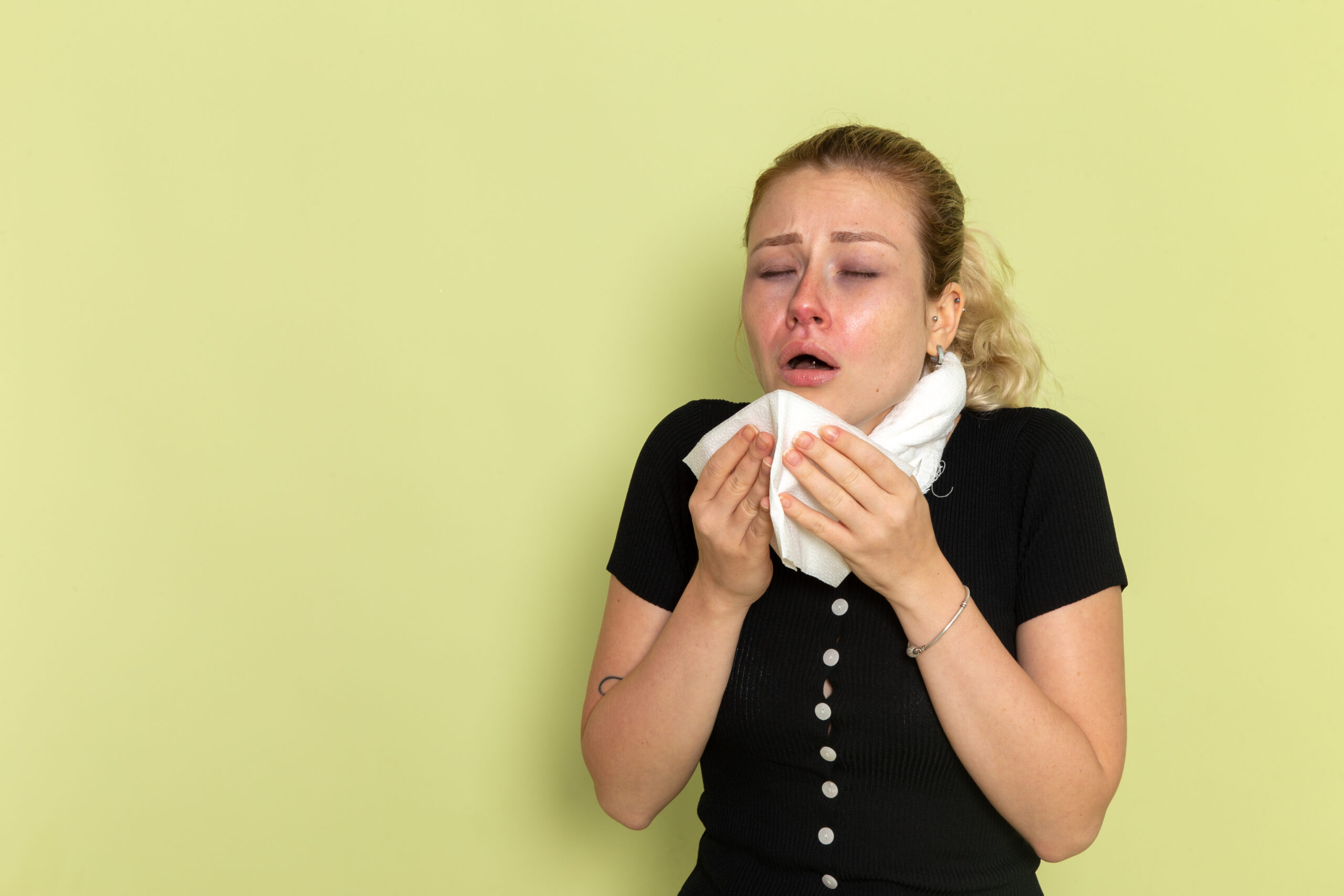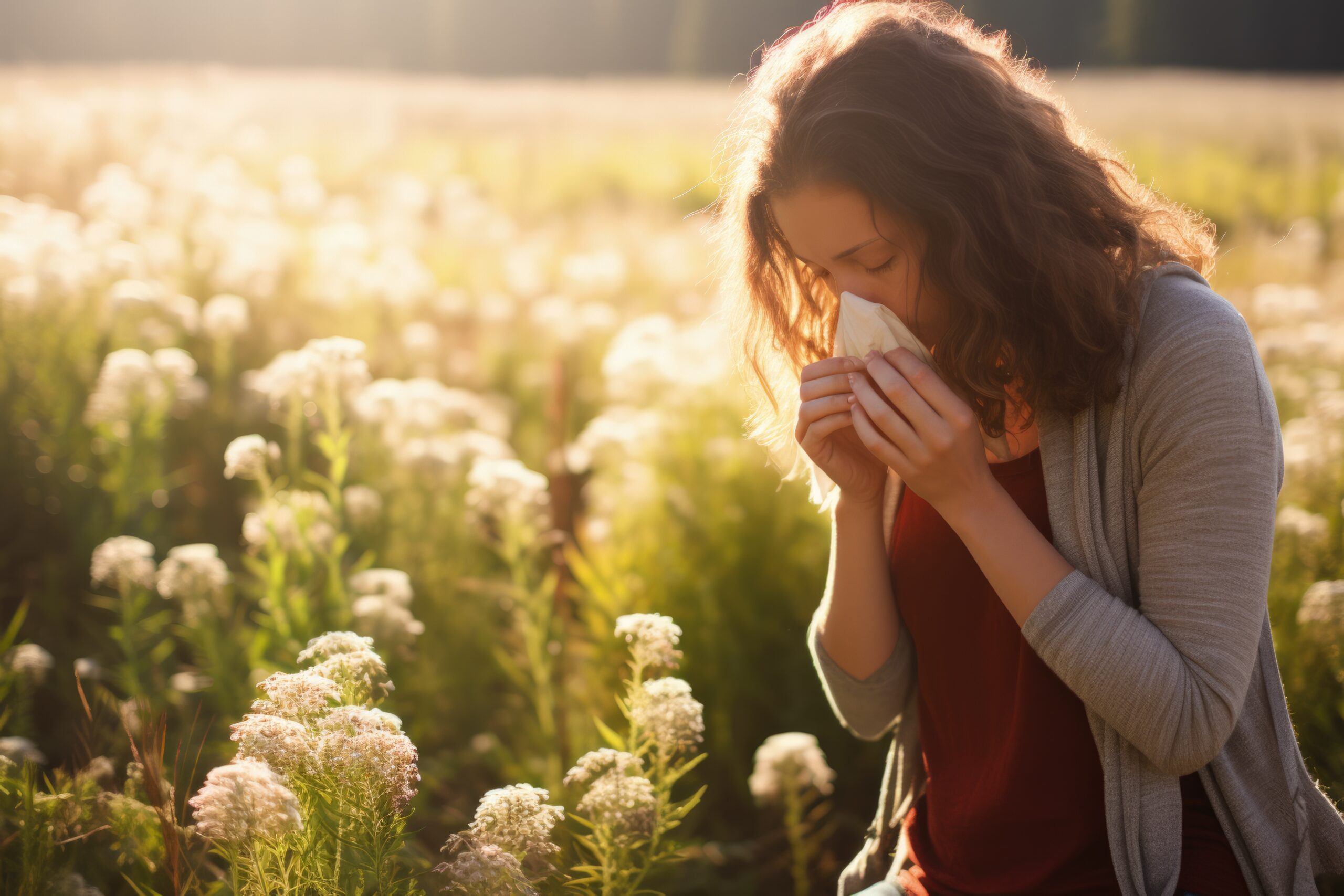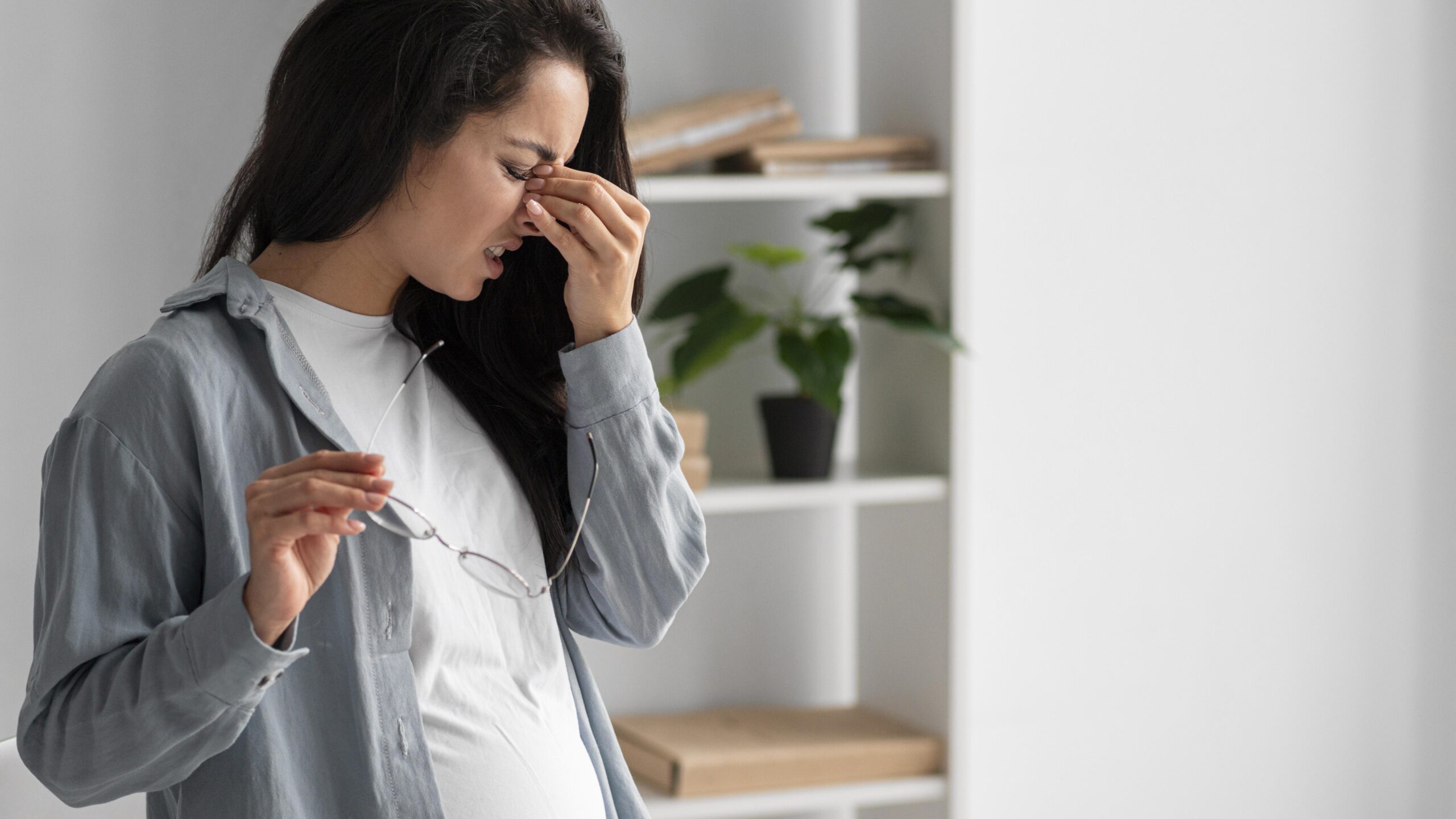Sneezing is a reflex that involves the rapid expulsion of air to clear the nasal mucosa of allergens, nasal and pharyngeal infections, dust, and impurities. The abdominal and intercostal muscles that contract during this process, as well as the closing larynx, create excess pressure in the chest, which, after unblocking the larynx, results in a rapid release of spray mist.
Sneezing is usually preceded by tickling or itching inside the nasal cavity, and a moment later, air is released under pressure. We should not fight this reflex because it is aimed at helping the body cope with external factors, the presence of which inside the respiratory tract could make breathing difficult. Additionally, the enormous pressure generated to throw the “intruder” out can wreak havoc inside if it encounters a closed passage.

Did you know that when you sneeze![]() , the moist mist of mucus, which contains germs, can travel 3 to 4.5 meters per second? It means that germs from sneezing can spread quite far, even up to 8 meters. These droplets, which can contain flu viruses, can remain in the air for up to 10 minutes and on surfaces for up to 24 hours. Specialists presume that one sick person in an office can directly infect up to three others, so it's essential to cover your nose and mouth when sneezing to prevent the spread of germs.
, the moist mist of mucus, which contains germs, can travel 3 to 4.5 meters per second? It means that germs from sneezing can spread quite far, even up to 8 meters. These droplets, which can contain flu viruses, can remain in the air for up to 10 minutes and on surfaces for up to 24 hours. Specialists presume that one sick person in an office can directly infect up to three others, so it's essential to cover your nose and mouth when sneezing to prevent the spread of germs.
Proper etiquette suggests that sneezing should be ignored as much as possible. If you need to sneeze, try to do so quietly and into a tissue or the crease of your arm to maintain hygiene. Avoid sneezing into the air or your hands, as it can be unhygienic. It's also considered more polite to use a cloth tissue rather than a disposable one unless you are sick. After sneezing, it's best to return to the conversation as if nothing happened, and those around should also pretend not to have noticed.
Sneezing is a natural defense mechanism that helps clear the nasal mucosa of harmful microorganisms. Below are some of the main causes![]() .
.
Allergic sneezing![]() is easy to recognize because it is accompanied by watery discharge. It usually happens in a tiring series, and the filled sinuses cause a headache. Hay fever is most often combined with redness and swelling of the eyelids. The rescue in the case of an allergy is to administer an antihistamine, which limits the development of the allergic reaction and – which is sometimes challenging – to recognize the factor triggering the symptoms and avoid interactions.
is easy to recognize because it is accompanied by watery discharge. It usually happens in a tiring series, and the filled sinuses cause a headache. Hay fever is most often combined with redness and swelling of the eyelids. The rescue in the case of an allergy is to administer an antihistamine, which limits the development of the allergic reaction and – which is sometimes challenging – to recognize the factor triggering the symptoms and avoid interactions.
However, it is difficult to avoid pollen, lime trees, or grasses in the long run, so it is worth considering desensitization treatment. This will permanently immunize us from tiring sneezing and other allergic symptoms. An allergist specialist can offer this type of help after performing appropriate tests and determining exactly what the allergy is.
A runny nose and sneezing in the case of a cold or flu are very familiar to us. During sneezing, thick secretions are expelled outside, usually yellowish, with which the nose seems to be filled to the brim. Often, sneezing and a runny nose are the first signs of infection![]() – it is worth not ignoring them and stocking up on a quick-response medicine containing a combined dose of vitamin C and other ingredients that boost immunity.
– it is worth not ignoring them and stocking up on a quick-response medicine containing a combined dose of vitamin C and other ingredients that boost immunity.
Drying out the nasal mucous membranes can also cause sneezing. This causes irritation and discomfort in the nose, which in turn leads to the sneezing reflex.
Frequent sneezing can also result from staying in rooms with insufficient air humidity. A way to moisten the air is, among others, placing wet towels on radiators or using air humidifiers.
To sum up, sneezing is a reflex that clears the respiratory tract of irritants (e.g., dust), viruses, bacteria, and allergens. The sneezing reflex should not be inhibited, but you should not sneeze on other people – this is how viruses and bacteria are transmitted via the so-called droplet route.
Sneezing in response to the sun, also known as ACHOO syndrome![]() (autosomal dominant compelling helio-ophthalmic outburst), is a common but not extensively researched reflex. This reflex, inherited in an autosomal dominant manner, occurs without any physical nasal irritants.
(autosomal dominant compelling helio-ophthalmic outburst), is a common but not extensively researched reflex. This reflex, inherited in an autosomal dominant manner, occurs without any physical nasal irritants.
Due to limited scientific research, the specific mechanism triggering sneezing in response to the sun remains not fully elucidated. However, it is hypothesized that simultaneous optic nerve and trigeminal nerve stimulation plays a crucial role. The proximity of the optic and trigeminal nerves allows the light impulse received by the optic nerve to potentially be mistaken as nasal cavity irritation, leading to the reflex of sneezing.
The mechanism of sneezing in response to the sun is also postulated to involve melanopsin, a photosensitive protein responsible for extravisual vision and circadian rhythm synchronization with environmental lighting conditions. Additionally, other hypotheses suggest the stimulation of the visual cortex or the corneal nerve as a potential explanation for the occurrence of ACHOO syndrome.

The sneezing reflex in the sun itself is not dangerous. So far, it has not been possible to link it to any known disease entity, although there have been reports of a potential relationship between sneezing in the sun and epileptic seizures, explained by a similar genetic background.
Indirectly, sneezing in response to the sun can be very dangerous. Pilots and drivers are mentioned as a risk group who sneeze violently, are blinded by a sudden ray of sunlight, and lose control over the machines they are driving. Momentary blackouts can result in serious accidents. The second situation in which sneezing in response to a bright light source can be dangerous is medical procedures. It applies to both minor dental interventions and more severe surgeries.
Sneezing under the influence of a dental lamp may result in minor injuries in the oral cavity while sneezing following more severe surgical procedures can lead to postoperative wound lacerations or secondary injuries related to increased pressure in the skull, eyeball, or abdominal cavity.
Alcoholic sneezing![]() occurs in people who are allergic to alcohol and is often a symptom of this characteristic allergy. What does it mean that sneezing after drinking alcohol may be allergic? Ingredients that cause allergic hypersensitivity are used to produce alcohol. These include fruits, hops, grains, and yeast.
occurs in people who are allergic to alcohol and is often a symptom of this characteristic allergy. What does it mean that sneezing after drinking alcohol may be allergic? Ingredients that cause allergic hypersensitivity are used to produce alcohol. These include fruits, hops, grains, and yeast.
Alcoholic beverages cause the release of histamine, which is responsible for the appearance of allergic symptoms such as hives, cough, itchy nose, or sneezing.
Sneezing after drinking alcohol is sometimes accompanied by additional respiratory symptoms (cough), skin changes (hives), or eye symptoms (redness or tearing). A common reaction to alcohol hypersensitivity is a runny nose and sneezing. Wines that contain many allergens, such as fruits and yeast, are a rich source of histamine and are mainly responsible for sneezing attacks during drinking.
Sneezing can also have other causes, such as those related to:
If sneezing becomes bothersome or worries you for another reason, it is always worth seeking advice from your family doctor, who will refer you to the appropriate specialist if necessary.
Frequent sneezing in children and adults is usually due to allergies or colds. Other factors may be responsible for frequent sneezing in newborns or infants, which usually worries parents. Meanwhile, sneezing in a newborn usually indicates properly functioning defensive reactions and cleanses the nasal mucosa. Dust, pollen, and breathing air itself are new to a newborn, so it may happen that it will sneeze quite often. As time passes, a newborn sneezes less often, although an infant still sneezes much more often than an older child.
Sneezing in an infant is due to the size and immatureness of the respiratory tract. A small child's nose is more easily blocked and irritated, associated with needing to clean it. Sneezing in infants may also result from milk getting into the nose during breastfeeding. In some toddlers, sneezing is observed when teething. A cough and a low-grade fever usually accompany it.
It sometimes happens that during pregnancy![]() , as a result of increased blood flow through the mucous membrane, the mucous membrane swells and the so-called pregnancy rhinitis. The nasal congestion and runny nose at that time can cause sneezing in pregnant women.
, as a result of increased blood flow through the mucous membrane, the mucous membrane swells and the so-called pregnancy rhinitis. The nasal congestion and runny nose at that time can cause sneezing in pregnant women.
Expectant mothers often wonder whether sneezing during pregnancy is dangerous and what the baby feels in the belly when the mother sneezes. There is no reason to worry; the baby floating in amniotic fluid is safe and cannot be threatened even by frequent sneezing during pregnancy.

Sneezing can induce significant pain by raising the pressure in the chest, abdominal cavity, and maxillary sinuses in cases involving broken or cracked ribs, acute discopathy, or an open maxillary sinus following tooth extraction.
There is a simple way to stop a sneeze. As soon as you feel the first symptom you want to sneeze, use the tip of your index finger to firmly pinch the tip of your nose and hold it until you feel the urge to sneeze has passed.
Sneezing is significant for the proper functioning of the body, so such reflexes should not be a cause for concern, even when they occur for no apparent reason. The mucous membrane is easily irritated by various stimuli, even as inconspicuous as changes in temperature or humidity, there is nothing atypical about this and it should not be treated as such. Frequent sneezing should be a cause for concern, especially when accompanied by other symptoms, such as red eyes, watery eyes, cough, runny nose, fever, or headache.
Such symptoms indicate allergies, a developing infection, and other conditions that require medical intervention, so it is worth consulting a doctor at a family practice or an ENT clinic. Quick diagnosis and appropriate treatment will free you from persistent sneezing and prevent further development of the disease and its possible complications.
The method of treating sneezing in each case depends on the causes of its occurrence.
Sneezing of allergic origin should be carefully diagnosed and treated![]() with methods for this type of condition.
with methods for this type of condition.
Sneezing caused by infection or cold is treated with generally available medical products![]() . It is worth reaching for preparations to remove accumulated nasal discharge.
. It is worth reaching for preparations to remove accumulated nasal discharge.
Most people believe that a runny nose should be waited out. To make life easier with sneezing, an inseparable element of a runny nose, try home remedies:
In the event of troublesome sneezing, you should remember that it is healthier to sneeze than to think about how to stop sneezing. Do not block your nose when sneezing, as it can result in eardrum, middle ear, or throat injuries.